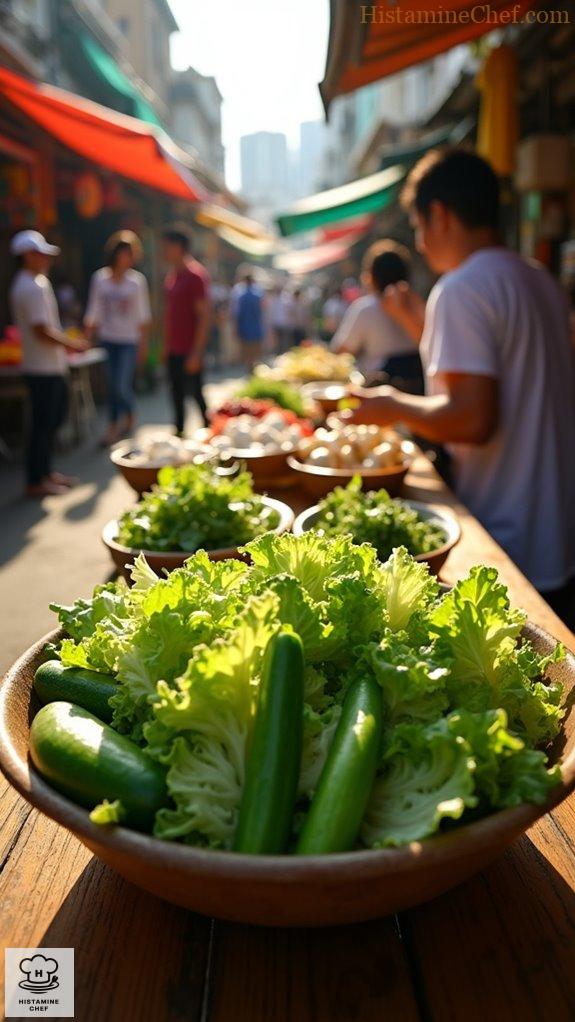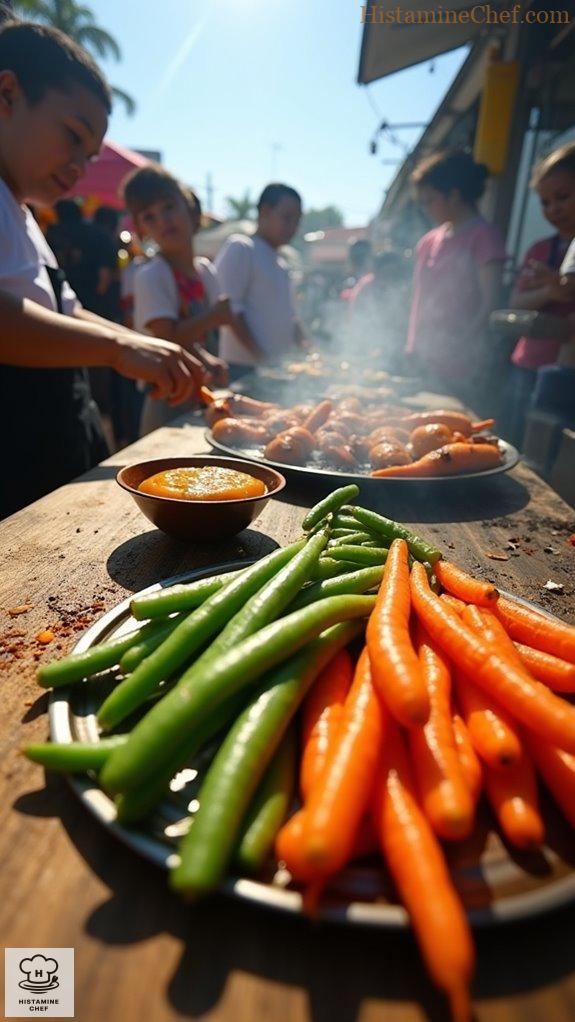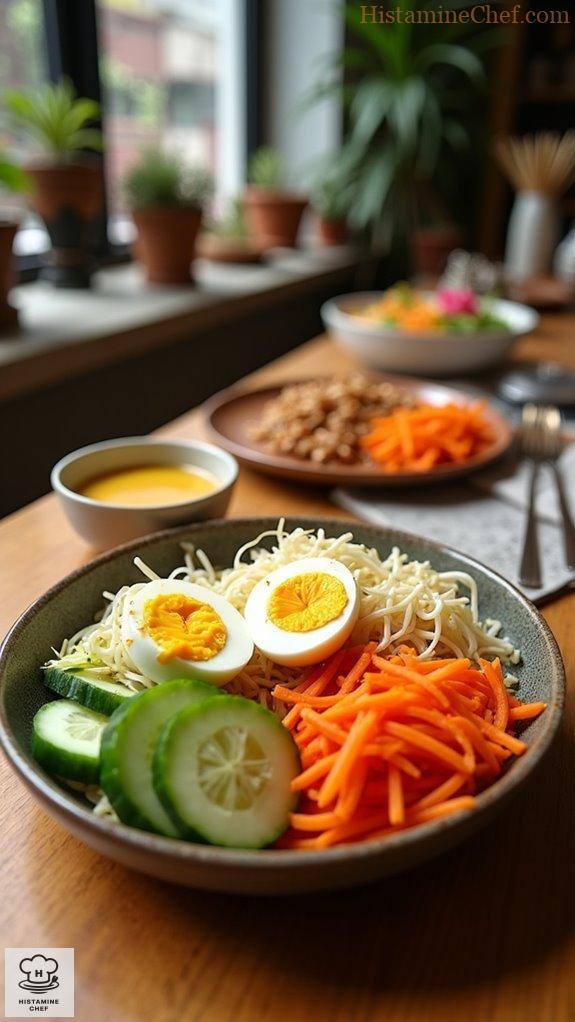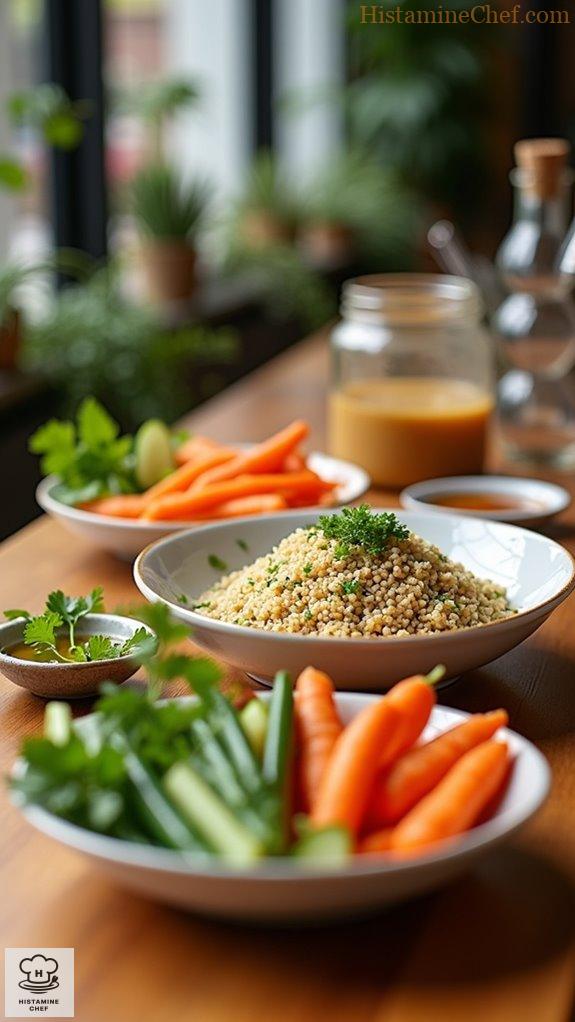If you think Gado Gado is just a fancy salad, think again! This lower histamine version packs a punch with grilled veggies like carrots and green beans, all topped with a creamy peanut sauce – but hold the processed stuff! Freshly ground peanuts keep it real, and how about swapping out tofu for tender chicken? Trust me, it’ll blow your mind! Ready to elevate your dining experience with vibrant flavors? Stick around to discover more delicious twists!
Culinary Hub of Southeast Asia

The street food culture of Southeast Asia is a vibrant tapestry of flavors, aromas, and culinary traditions, reflecting the region’s rich history and diverse influences. From bustling night markets in Thailand to the hawker centers of Singapore, street food offers a wide array of dishes that are both affordable and delicious.
Historically, the origins of street food can be traced back to the urbanization of Southeast Asian cities in the early 20th century, when street vendors began to cater to the growing population of workers seeking convenient meals. This led to the emergence of iconic dishes, such as Indonesia’s Gado Gado, a colorful salad featuring vegetables, boiled eggs, and a rich peanut sauce.
The accessibility and communal nature of street food foster a unique social atmosphere, where locals and tourists alike gather to share culinary experiences. As street food continues to evolve, it remains a quintessential part of Southeast Asian identity, celebrating local ingredients and traditional cooking techniques passed down through generations, while also embracing innovation and creativity that captivate palates around the world.
Grilled on Charcoals Outdoors

Street vendors typically prepare Gado Gado outdoors over charcoals, infusing a smoky flavor into the dish.
They start by grilling an assortment of fresh vegetables—such as green beans, carrots, and cabbage—until they’re tender but still crisp.
The grilled vegetables are then assembled on a platter, topped with a rich peanut sauce made from roasted ground nuts, garlic, and sweeteners. Vendors often finish the dish with hard-boiled eggs or crumbled hard cheeses, depending on local preferences.
The presentation showcases vibrant colors, enticing passersby to indulge in this nutritious street food.
Ingredients Needed:
- 2 cups green beans
- 2 medium carrots
- 1 cup cabbage
- 2 medium potatoes
- 4 hard-boiled eggs
- 1 cup peanut butter
- 2 tablespoons honey
- 1 tablespoon coconut oil
Cooking Steps:
- Grill vegetables over charcoal.
- Boil potatoes until tender.
- Mash peanut butter in a bowl.
- Add honey and mix well.
- Arrange grilled vegetables on platter.
- Slice hard-boiled eggs.
- Drizzle peanut sauce over vegetables.
- Serve immediately to enjoy freshness.
Prepare Fresh Ingredients Daily

To prepare Street Style Gado Gado at home, focus on using fresh, allowed vegetables such as carrots, cucumber, and bean sprouts, and keep the dish vibrant by incorporating a variety of colors.
Instead of using traditional peanut sauce, create your own version using sunflower seeds as a base, mixed with allowed sweeteners like honey and a dash of coconut milk for creaminess.
Steam or lightly boil the vegetables to maintain their crispness and nutrients, and serve them on a plate topped with the homemade sauce.
Remember to include soft-boiled quail eggs for added protein and flavor, while avoiding any high-histamine ingredients.
Cooking Steps/Ingredients Changed:
- Use fresh allowed vegetables
- Substitute sunflower seeds for peanuts
- Sweeten sauce with honey
- Add coconut milk for creaminess
- Steam vegetables instead of frying
- Include soft-boiled quail eggs
- Omit high-histamine ingredients
Low Histamine Variation of Gado Gado

Street food, known for its bold flavors and diverse ingredients, can pose significant challenges for those with histamine intolerance. Many traditional street food dishes incorporate ingredients high in histamine or liberators that can trigger adverse reactions. Understanding the SIGHI list can help navigate these choices and find safer alternatives.
Eating street food like Gado Gado can be problematic for individuals with histamine intolerance because it often includes restricted ingredients like tofu, fermented sauces, and high-histamine vegetables such as tomatoes and avocados.
In addition, the freshness of ingredients can vary, leading to unknown histamine levels in prepared foods. According to the SIGHI list, certain legumes, dressed salads, and fermented items commonly found in street Gado Gado can exacerbate symptoms in sensitive individuals.
Instructions for Low Histamine Gado Gado:
- Replace tofu with cooked chicken or turkey for protein.
- Avoid using high-histamine vegetables such as tomatoes or spinach.
- Use freshly prepared peanut butter instead of any processed sauces.
- Substitute traditional dressing with extra virgin olive oil and apple vinegar.
- Include allowed vegetables like carrots, cucumber, and green beans only.
- Cook vegetables only until tender, not overcooked to preserve freshness.
- Serve with quinoa or rice as a low histamine starch choice.
- Omit any fermented ingredients, keeping flavors natural and fresh.
- Use fresh herbs like cilantro or parsley for added flavor without triggers.
- Plate immediately to prevent histamine build-up from standing meals.
Video Summary
Gado Gado is a traditional Indonesian salad showcasing the vibrant flavors of street food cuisine. In this video, we’ll explore both the authentic street version and a lower histamine home adaptation.
Street vendors prepare Gado Gado with a colorful mix of fresh vegetables. They often include bean sprouts, cabbage, carrots, and green beans, all blanched just right to retain crunchiness. A key component is the rich peanut sauce made from roasted peanuts, palm sugar, and spicy chili. Vendors typically use a mortar and pestle to crush the peanuts and blend the ingredients. The sauce is thick and creamy, drizzled generously over the vegetables.
It’s also common to top the dish with cooked egg whites, adding a protein boost. Vendors often serve it with rice cakes or fried tofu, amplifying the delightful experience.
For a lower histamine home version, start with fresh, allowed vegetables like carrots, green beans, and cabbage. Substitute the peanut sauce with tahini mixed with a bit of honey and distilled white vinegar. Use a blender for smooth mixing.
Omit the egg whites entirely; instead, include cooked quail eggs. Skip the fried tofu and serve the dish with cooked yam or rice cakes made with rice flour. Use fresh herbs like cilantro for an aromatic finish.
The final meal will be colorful and delicious, bursting with freshness and nutty flavors. Check the link in the description for the full recipe.


Leave a Reply